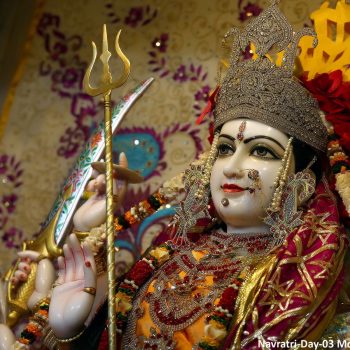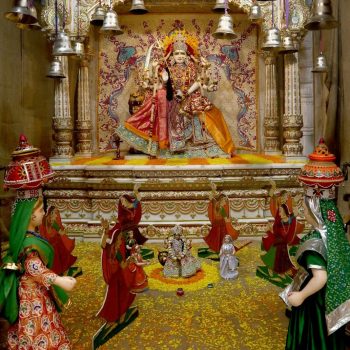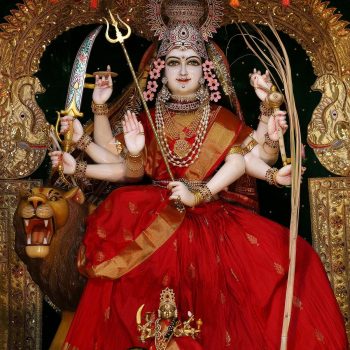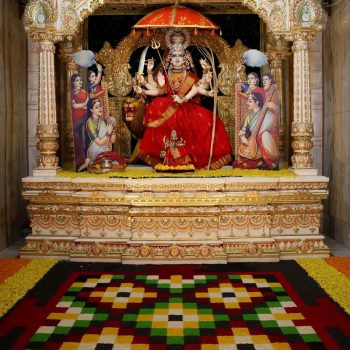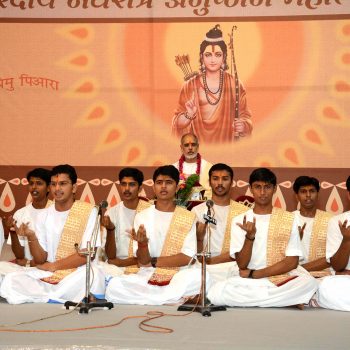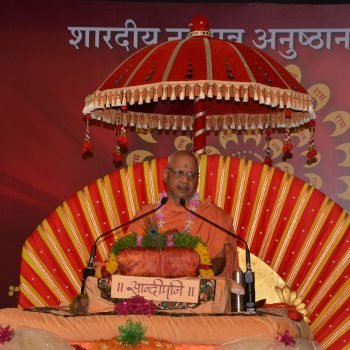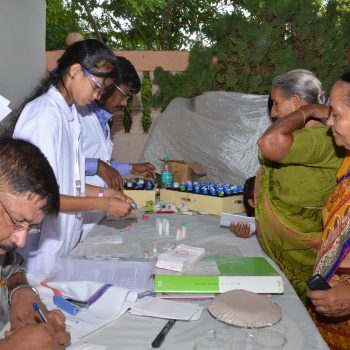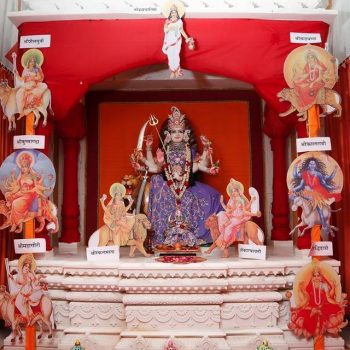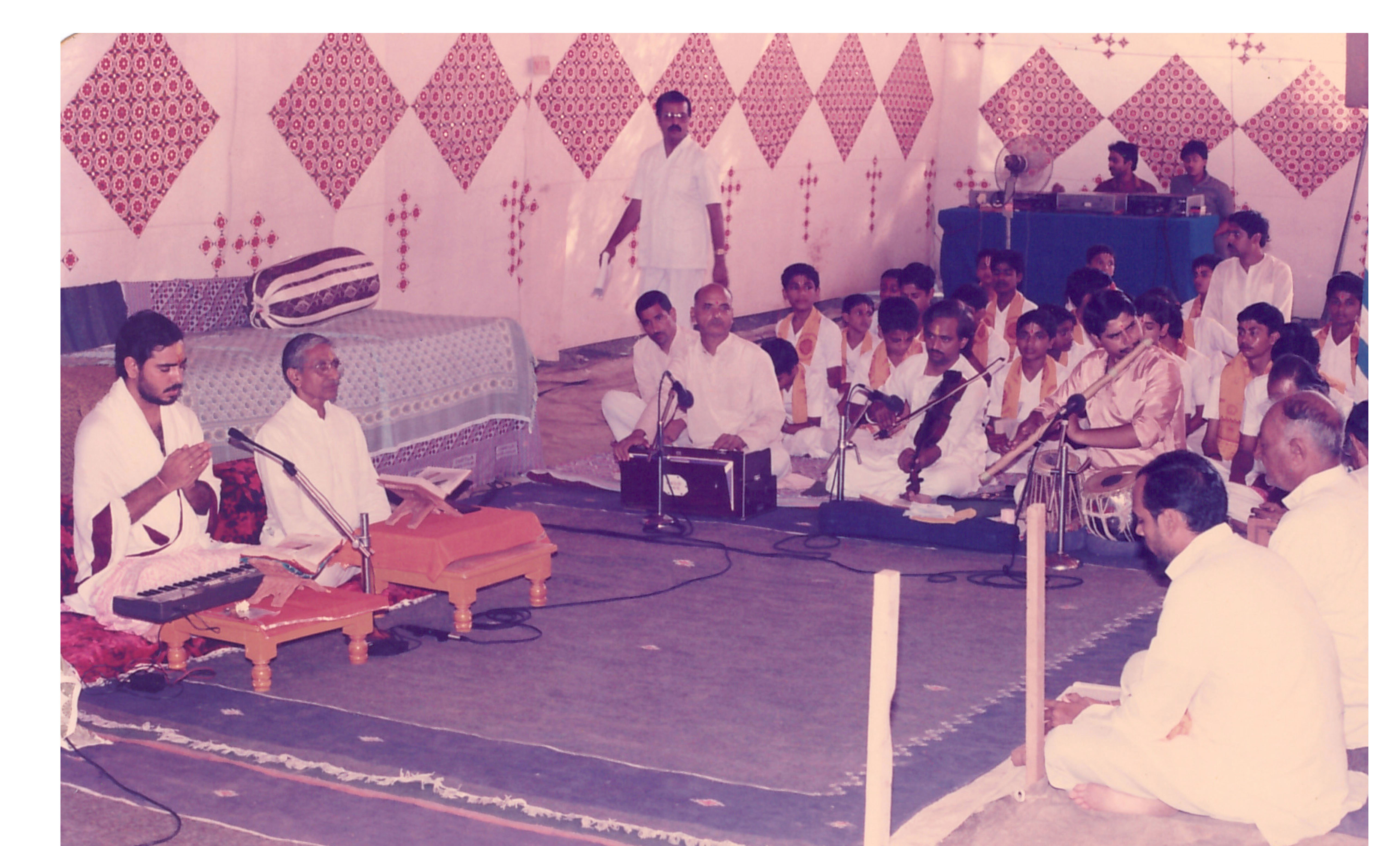The Journey of a woman depicted through the different forms of Mā Parāmbā Bhagavati:
Śrīhariṃ paramānandamupadeṣṭāramīśvaram ।
Vyāpakaṃ sarvalokānāṃ kāraṇaṃ taṃ namāmyaham ॥
Bhavānīśaṅkarau vande śraddhāviśvāsarūpiṇau।
Yābhyāṃ vinā na paśyanti siddhāḥsvāntaḥsthamīśvaram ॥
Sarvamaṅgalamāṅgalye śive sarvārthasādhike ।
Śaraṇye tryambake gauri nārāyaṇi namo’stu te ॥
During Navarātri, we celebrate and worship the manifestation of the Absolute Reality (Brahma) as the feminine and motherly (vātsalya) energy in the form of Mā Parāmbā Bhagavati. Although Mā Parāmbā Bhagavati manifests in nine main forms during the nine days of Navarātri, this article will focus on the journey of a woman, as explained by Pujya Bhaishri, through illustrating the significance behind a few of Mā Parāmbā Bhagavati’s forms (avatāras); namely, Her first five forms— Mā Śailaputrī, Mā Brahmacāriṇī, Mā Caṃdraghaṃṭā, Mā Kūṣmāṇḍā and Mā Skaṃdamātā.
Mā Śailaputrī is the first form of Mā Parāmbā Bhagavati who is worshipped in Her nine manifestations called Navadurgā. She is named “Śailaputrī”, since She is the daughter of the mountain king— himācala. In Her previous birth, she was Dakṣa Prajāpati’s daughter—Sati, who was married to Lord Śiva; before Sati immolated Herself in the sacrificial fire, She had asked to only to be wedded to Lord Śiva in her every birth:
Sati marata hari sana baru māgā, janama janama siva pad anuragā |
Tehi kārana himagiri gruh jāī, janami pārabatī tanu pāī ||
She was reborn as Mā Śailaputrī (also known as Pāravati or Hemavati). Mā Śailaputrī is a small girl (bālika), whose nature is gentle and compliant. Her birth symbolises the prosperity and joy that every girl brings to her family. It also shows the respect that we should pay towards the feminine energy, throughout her journey from a small girl (who is under the protection of her father) to the old woman (who is under the protection of her son). When Mā Śailaputrī was born in Himācala, many ṛṣi came to Himācala, and made hermitages (āśramas). Through their penance (tapasyā), the country began to prosper. Nāradaji too, came to their home. Amongst his many roles, at Mā Śailaputrī’s home he came as an astrologer (jyotiṣa) to read Mā Śailaputrī horoscope (kuṃḍalī). He informed Her parents that it seems like she’s going to get a very special husband, mentioning Lord Śiva, and then describing the His ten qualities—after which both parents were shedding tears of sorrow, whilst Mā Śailaputrī was shedding tears of happiness; because She realised that she was going to attain Lord Śiva, as she had asked for. Nāradaji consoles the parents, explaining to them that there will be nothing greater than Mā Śailaputrī attaining Lord Śiva as her husband, and that if she does tapasyā, she will surely attain Him.
After seeking her parents’ blessings to go perform penance to attain Lord Śiva, Mā Śailaputrī leaves Her home to perform severe penance in the forest, and thus becomes known as Mā Brahmacāriṇī —the second avatāra of Mā Parāmbā Bhagavati. “Brahma” means penance or observance of strict disciplines; and “Brahmacāriṇī” means the one who observes spiritual penance and behaves with austerity. Therefore, Pujya Bhaishri explains that in one perspective, a woman’s life is tapasyā from the day that she is born. She first serves her family by upholding her father’s honour and dignity, and in this phase of her life, every girl does rigorous tap to attain a suitable boy and family.
After having performed extremely severe penance, to the point where Her body became emaciated, Mā Brahmacāriṇī attains Lord śiva, and gets married to Him. Thus, She is now known as Mā Caṃdraghaṃṭā (the third form of Mā Parāmbā Bhagavati)—the married form of Mā Parāmbā Bhagavati, in all her adornment (śrṛṃgāra). This form of Mā represents the transition of a girl to a married woman entering the householder (gṛhastha āśram) stage of life. She is a housewife, whose face is like a moon (caṃdra) and radiating moonlight, and voice is as sweet as a bell (ghanti); signifying how a woman is best suited in sweet speech and a gentle temperament. She has ten hands, highlighting the various and unending tasks a married woman has to carry out (taking care of her husband, in-laws, children, the house, etc), and being able to do them all equally well—thus, she’s a multitasker. Mā Caṃdraghaṃṭā epitomises a married woman’s dedication and correspondence towards the husband, such that she slowly becomes like him (pati ki svarūpa).
When a married woman is ready to create a new world, a new life, after marriage, she is known as Mā Kūṣmāṇḍā, explains Pujya Bhaishri. Mā Kūṣmāṇḍā, who is the fourth form of Mā Parāmbā Bhagavati worshipped in Her nine manifestations, is known to have created the universe with just her smile. Thus, Pujya Bhaishri here connects this avatāra to the journey of a woman, by pointing out why most women get married: to have their own house, children and a prosperous family! More specifically, he mentions the two desires that most women have: 1) to get a suitable husband, and 2) to be a mother to good children. Thus, after having attained a suitable husband, Mā Kūṣmāṇḍā represents that feminine energy’s willingness or readiness—to create and uphold for nine months, the creation of a new universe (in the form of a new life) within Her. This form represents every woman’s desire to create her own world; her own family.
Mā Skaṃdamātā, who is the fifth form of Mā Parāmbā Bhagavati worshipped in her nine manifestations, is the mother of her first born child, Kārtikeya (also known as Skanda). In this form, we worship Mā Parāmbā Bhagavati specifically as Kārtikeya’s mother, hence, the term— Skaṃdamātā. Whenever a woman becomes a mother, she becomes or feels complete. She feels so complete in becoming a mother, she no longer feels the need for any other creation or venture to complete her, explains Pujya Bhaishri. Yes, if she wants to do out of her own joy, it’s a different thing; but it’s no longer a need because to become a mother is absolute good fortune (param saubhāgya) for a woman and the sign of fulfillment (pūrṇatā). Thus, the married woman who is now a mother, with a baby playing in her lap, busy feeding it and bringing it up with virtuous values (saṃskāras), is the very form of Mā Skaṃdamātā, reveals Pujya Bhaishri.
Although we worship the nine manifestations of Mā Parāmbā Bhagavati that we worship during the journey of the nine days of Navarātri;
Prathamaṃ śailaputrī ca dvitīyaṃ brahmacāriṇī ।
Tṛtīyaṃ candraghaṇṭeti kūṣmāṇḍeti caturthakam
Pañcamaṃ skandamāteti ṣaṣṭhaṃ kātyāyanīti ca ।
Saptamaṃ kālarātrīti mahāgaurīti cāṣṭamam
Navamaṃ siddhidātrī ca navadurgāḥ prakīrtitāḥ ।
Devīkavacam 3-5
This article focuses on the first five forms of Mā Parāmbā Bhagavati, owing to Pujya Bhaishri’s unique and relevant elucidation of what they each mean in relation to a woman’s journey in the present day. May we recognise and honour the feminine energy that lies within every woman, and respect her, because her very life is a loving sacrifice (yajña)!
Jai Mā!
